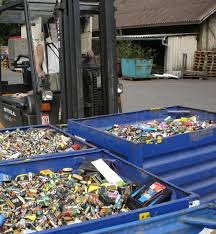The battery is the element that contains different metals in its composition, like mercury in flat batteries, or cadmium in rechargeable batteries. There are other worrying toxic metals such as magnesium, nickel and zinc. Therefore, although not all batteries have the same level of toxicity, they all have a high concentration in metals that should be considered a dangerous residue.
Batteries facilitate the use of various gadgets that we use in our daily lives, but if we throw them away with ordinary rubbish, they end up in landfills or incinerating plants.
Contamination of Batteries
In landfills, with time, the exterior shell of the battery is eroded and the inside is tipped and transferred into subterranean waters and the earth, which causes them to enter the nature food chain, from which human beings nourish.At incinerating plants, resulting fumes will give way to volatile toxic elements, contaminating the air.
How do batteries contaminate?
Batteries that are tossed into landfills or for that matter thrown onto any terrain that is not specialised in the disposal of this type of material, cause a great impact the nature and fauna of that area.
Batteries take a long period of time to disintegrate and therefore contaminate slowly, during a long period of time in any given ecosystem. Here are several ways in which batteries contaminate the ecosystem:
Batteries take a long period of time to disintegrate and therefore contaminate slowly, during a long period of time in any given ecosystem. Here are several ways in which batteries contaminate the ecosystem:
- The toxic substances that batteries emit whilst they are decomposing contaminate the air, causing harmful effects to the health of living beings.
- On the other hand, batteries also contaminate the ground. This provokes changes to the ecosystems. Fertile ground diminishes in these areas, leading to deaths of animals and living beings in those areas because of the diminished food resources.
- Waste from batteries also contaminate the water, superficial and subterranean waters, causing widespread problems and annihilation of agriculture and livestock, and especially to the marine ecosystems.
Picking and selecting batteries
Picking used batteries and placing them in specific containers, and adequate treatment are the most logical and respectful solution for environment.
Once they have been collected from these specific containers for batteries only, they are transported to recycling plant where the dangerous metal parts are segregated from the rest of materials. Unfortunately, very few plants exist dedicated to the recycling of batteries. The process is somewhat costly, and the costly environmental repercussions are often ignored.
What you can do from home
We can also collaborate when it comes to preventing the damages of batteries. We can opt for rechargeable batteries (see image below) which can be used up to 500 times before they need to be disposed of. Because they can be reused, they are even more convenient that conventional batteries.
Zinc-carbon batteries are also an alternative, but the best thing is to buy electrical items that can be connected and plugged in to an electrical current.
 |
| These rechargeable batteries can be reused up to 500 times |
Getting rid of batteries
When it comes to getting rid of batteries the best option is to deposit the batteries in the places allocated for their collection and safe disposal. Some major supermarkets and stores in the UK (Argos, Sainsbury's, Homebase, B&Q and Tescos) with rubbish tips usually have a separate container for batteries to be recycled.
Statistics
However it is notable that there aren't enough options in the UK to recycle batteries when they are so commonly used to power household electrical goods.In 2012 in the UK, only a 32% of batteries were recycled. Compare this to Switzerland, where in the same year 73% of batteries were recycled, and the results are dire.
Tags: Hazards of batteries lying in landfills

